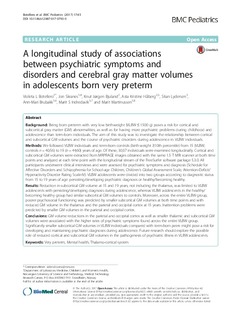| dc.contributor.author | Lozano-Botellero, Violeta Nazaret | |
| dc.contributor.author | Skranes, Jon Sverre | |
| dc.contributor.author | Bjuland, Knut Jørgen | |
| dc.contributor.author | Håberg, Asta | |
| dc.contributor.author | Lydersen, Stian | |
| dc.contributor.author | Brubakk, Ann-Mari | |
| dc.contributor.author | Indredavik, Marit Sæbø | |
| dc.contributor.author | Martinussen, Marit | |
| dc.date.accessioned | 2017-03-16T08:59:39Z | |
| dc.date.available | 2017-03-16T08:59:39Z | |
| dc.date.created | 2017-03-01T16:20:16Z | |
| dc.date.issued | 2017 | |
| dc.identifier.issn | 1471-2431 | |
| dc.identifier.uri | http://hdl.handle.net/11250/2434280 | |
| dc.description.abstract | Background:Being born preterm with very low birthweight (VLBW≤1500 g) poses a risk for cortical andsubcortical gray matter (GM) abnormalities, as well as for having more psychiatric problems during childhood andadolescence than term-born individuals. The aim of this study was to investigate the relationship between corticaland subcortical GM volumes and the course of psychiatric disorders during adolescence in VLBW individuals.Methods:We followed VLBW individuals and term-born controls (birth weight≥10th percentile) from 15 (VLBW;controlsn=40;56)to19(n= 44;60) years of age. Of these, 30;37 individuals were examined longitudinally. Cortical andsubcortical GM volumes were extracted from MRPRAGE images obtained with the same 1.5 T MRI scanner at both timepoints and analyzed at each time point with the longitudinal stream of the FreeSurfer software package 5.3.0. Allparticipants underwent clinical interviews and were assessed for psychiatric symptoms and diagnosis (Schedule forAffective Disorders and Schizophrenia for School-age Children, Children’s Global Assessment Scale, Attention-Deficit/Hyperactivity Disorder Rating Scale-IV). VLBW adolescents were divided into two groups according to diagnostic statusfrom 15 to 19 years of age: persisting/developing psychiatric diagnosis or healthy/becoming healthy.Results:Reduction in subcortical GM volume at 15 and 19 years, not including the thalamus, was limited to VLBWadolescents with persisting/developing diagnosis during adolescence, whereas VLBW adolescents in the healthy/becoming healthy group had similar subcortical GM volumes to controls. Moreover, across the entire VLBW group,poorer psychosocial functioning was predicted by smaller subcortical GM volumes at both time points and withreduced GM volume in the thalamus and the parietal and occipital cortex at 15 years. Inattention problems werepredicted by smaller GM volumes in the parietal and occipital cortex.Conclusions:GM volume reductions in the parietal and occipital cortex as well as smaller thalamic and subcortical GMvolumes were associated with the higher rates of psychiatric symptoms found across the entire VLBW group.Significantly smaller subcortical GM volumes in VLBW individuals compared with term-born peers might pose a risk fordeveloping and maintaining psychiatric diagnoses during adolescence. Future research should explore the possiblerole of reduced cortical and subcortical GM volumes in the pathogenesis of psychiatric illness in VLBW adolescents. | nb_NO |
| dc.language.iso | eng | nb_NO |
| dc.publisher | BioMed Central | nb_NO |
| dc.rights | Navngivelse 4.0 Internasjonal | * |
| dc.rights.uri | http://creativecommons.org/licenses/by/4.0/deed.no | * |
| dc.title | A longitudinal study of associations between psychiatric symptoms and disorders and cerebral gray matter volumes in adolescents born very preterm | nb_NO |
| dc.type | Journal article | nb_NO |
| dc.type | Peer reviewed | nb_NO |
| dc.source.volume | 17 | nb_NO |
| dc.source.journal | BMC Pediatrics | nb_NO |
| dc.source.issue | 1 | nb_NO |
| dc.identifier.doi | 10.1186/s12887-017-0793-0 | |
| dc.identifier.cristin | 1455102 | |
| dc.description.localcode | © The Author(s). 2017 Open AccessThis article is distributed under the terms of the Creative Commons Attribution 4.0International License (http://creativecommons.org/licenses/by/4.0/), which permits unrestricted use, distribution, andreproduction in any medium, provided you give appropriate credit to the original author(s) and the source, provide a link tothe Creative Commons license, and indicate if changes were made. The Creative Commons Public Domain Dedication waiver(http://creativecommons.org/publicdomain/zero/1.0/) applies to the data made available in this article, unless otherwise stated.Botelleroet al. BMC Pediatrics (2017) 17:45 DOI 10.1186/s12887-017-0793-0 | nb_NO |
| cristin.unitcode | 194,65,1,0 | |
| cristin.unitcode | 194,65,10,0 | |
| cristin.unitcode | 194,65,30,0 | |
| cristin.unitcode | 194,65,35,0 | |
| cristin.unitname | DMF fakultetsadministrasjon | |
| cristin.unitname | Institutt for laboratoriemedisin, barne- og kvinnesykdommer | |
| cristin.unitname | Institutt for nevromedisin | |
| cristin.unitname | Regionalt kunnskapssenter for barn og unge - Psykisk helse og barnevern | |
| cristin.ispublished | true | |
| cristin.fulltext | original | |
| cristin.qualitycode | 1 | |

